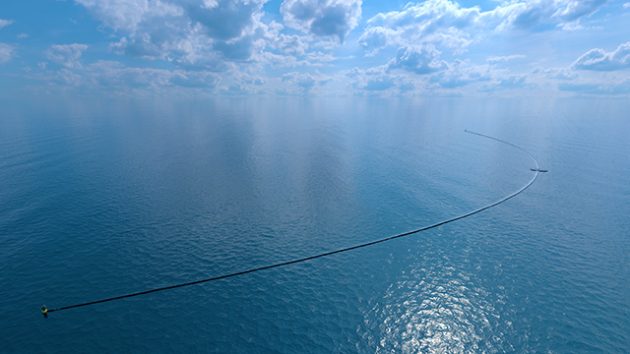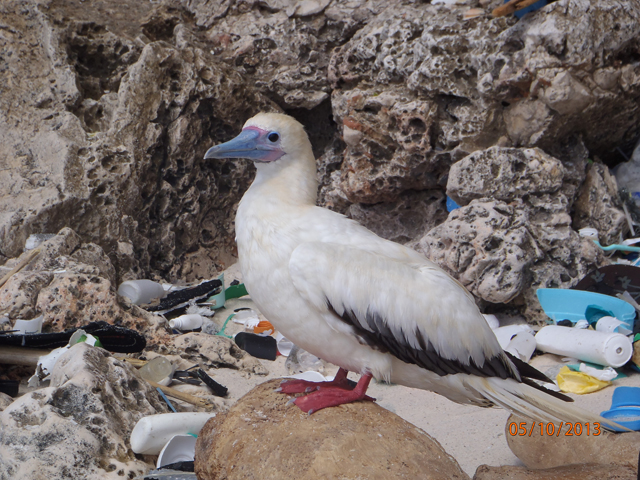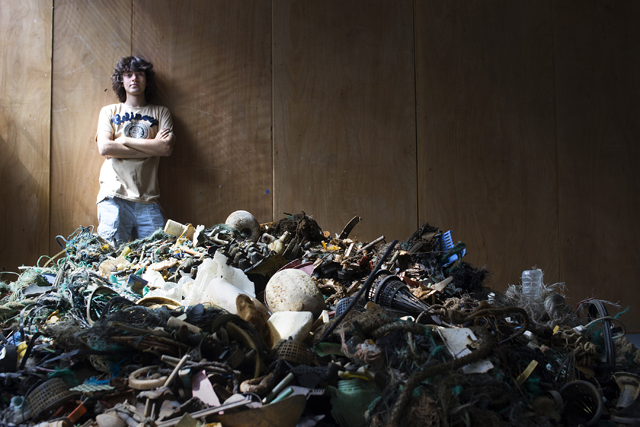The Ocean Cleanup, the Dutch foundation developing advanced technologies to rid the oceans of plastic, is to start extracting plastic from the Great Pacific Garbage Patch within the next 12 months.
The Ocean Cleanup has also announced that parts of its first clean-up system are already in production. Thanks to an improved design, The Ocean Cleanup has increased the efficiency of the system, allowing for the clean up of half the Great Pacific Garbage Patch in just five years.
The main idea behind The Ocean Cleanup is to let the ocean currents do the work. An installation of U-shaped screens channels floating plastic to a central point. The concentrated plastic can then be extracted and shipped to shore for recycling into durable products.

The Ocean Cleanup computer rendering, underwater view. Credit: Erwin Zwart/The Ocean Cleanup
The improvements involve the introduction of a mobile, or drifting system. Rather than fixing the floating screens to the seabed at great depths, The Ocean Cleanup will apply sea anchors to ensure the floating screens move slower than the plastic. Rather than one massive barrier, the improved, modular clean-up system consists of a fleet of screens.
This new, modular technology and the successful funding round announced on 3 May 2017, enable The Ocean Cleanup to accelerate production, deployment and the actual extraction of plastic from the ocean.
Testing of the first system will start off the American west coast by the end of 2017. With the first deployment in the Great Pacific Garbage Patch in the first half of 2018, The Ocean Cleanup will start its mission two years ahead of schedule.
The first parts of the clean-up system involve four 12-meter (40-foot) high anchor components.

The Ocean Cleanup computer rendering, anchor close-up. Credit: Erwin Zwart/The Ocean Cleanup
The Ocean Cleanup’s founder and CEO Boyan Slat said that the large-scale trials of its clean-up technology in the Pacific Ocean later this year are still experimental in nature.
‘Due to our attitude of ‘testing to learn’ until the technology is proven, I am confident that – with our expert partners – we will succeed in our mission.’

The Ocean Cleanup computer rendering, close-up. Credit: Erwin Zwart/The Ocean Cleanup
Plastic in 99 per cent of seabirds by 2050
CSIRO and Imperial College London researchers predict that plastic ingestion will affect 99 per cent of the world’s seabird species…
Number of plastic bags on UK beaches halved in just one year
The Marine Conservation Charity says 5p has been small price to pay for fewer carrier bags at the coast
Huge volume of plastic discovered on remote Pacific Island
Henderson Island, one of the world’s most remote islands in the South Pacific, has been found to be littered with…
Teenager invents feasible solution to clean up ocean plastic
The Ocean Cleanup is seeking to crowd fund $2million for the next phase of the project
Global plastic input from rivers into oceans
Last week, researchers at The Ocean Cleanup published the first-ever estimate of plastic emissions from rivers into the world’s oceans.
Writing in Nature Communications, they calculate that rivers annually transport between 1.15 and 2.41 million metric tons of plastic waste into our oceans. Two-thirds of this input comes from the 20 most polluting rivers, most of which are located on the Asian continent.
It is commonly accepted that most plastic found in the oceans originates from land-based sources. It is also well known that rivers play a particularly important role in transporting mismanaged plastic waste from land into the ocean. Until now, however, researchers had quantified neither the total amount of plastic flowing out of the world’s rivers, nor how much plastic is emitted by each individual river. With today’s study, this information is now available.

Global plastic input from rivers into oceans. Credit: The Ocean Cleanup
For this study, a team lead by The Ocean Cleanup researcher Laurent Lebreton created a model from the combined global geospatial information on: population density, waste management, topography, hydrography and the locations of dams. After calibrating the model against field measurements of plastic flows from various rivers across the world, it was used to obtain a global picture of the annual river plastic emissions into the oceans.
Of the 40,760 ocean-bound rivers studied, just 20 are responsible for two-thirds of the global plastic input. In total, between 1.15 and 2.41 million metric tons of plastic are deposited into the oceans by rivers. The model also shows that plastic input from rivers is highly correlated with drainage of debris from the river banks and creeks leading into main waterways, and that this river-to-ocean input therefore varies per season. Worldwide, three quarters of the plastic released annually enters the oceans between May and October.

The Ocean Cleanup’s founder and CEO Boyan Slat. Photo: The Ocean Cleanup/pierreaugier.com
Boyan Slat said: ‘We’re pleased to see how many initiatives have been taken in the past few years to raise awareness of the ocean pollution problem. However, for our work in the deep ocean to succeed in the long run, it’s crucial that governments and other organizations speed up their efforts to mitigate the sources of the problem we aim to resolve. The results of this latest study can assist with those efforts.’








